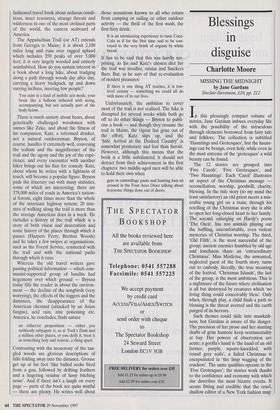Blessings in disguise
Charlotte Moore
MISSING THE MIDNIGHT by Jane Gardam Sinclair-Stevenson, £10, pp. 212 n this pleasingly compact volume of stories, Jane Gardam imbues everyday life with the possibility of the miraculous through elements borrowed from fairy tale and folklore. The collection is subtitled `Hauntings and Grotesques', but the haunt- ings can be benign, even holy, while even in the most extreme of the 'grotesques' a wild beauty can be found.
The 12 stories are grouped into `Five Carols', 'Five Grotesques', and `Two Hauntings'. Each `Carol' illustrates an aspect of the Christmas message reconciliation, worship, goodwill, charity, blessing. In the title story (to my mind the least satisfactory) an old priest meets a mis- erable young girl on a train; through his retelling of the Christmas story she is able to open her long-closed heart to her family. The second, enlarging on Hardy's poem `The Oxen', has zoo animals playing out the baffling, uncomfortable, even violent mysteries of Christian worship. The third, `Old Filth', is the most successful of the group; ancient enemies humbled by old age and loneliness share an 'extraordinary Christmas'. Miss Mistletoe, the unwanted, neglected guest of the fourth story, turns out to embody, literally, the true meaning of the festival. 'Christmas Islands', the last of the group, is the most ambitious. This is a nightmare of the future where civilisation is all but destroyed by creatures which 'no living thing could conceivably bless'. Only when, through play, a child finds a path to blessing is the threat averted and the earth purged of its horrors.
Such themes could slide into mawkish- ness, but Gardam is aware of the danger. The precision of her prose and her slanting shafts of grim humour keep sentimentality at bay. Her powers of observation are acute; a gorilla's hand is 'the hand of an old farmer, purple, square-knuckled, with round grey nails', a failed Christmas is encapsulated in 'the limp wagging of the crackers'. The same qualities operate in the `Five Grotesques'; the stories work thanks to the confidence and economy with which she describes the most bizarre events. It seems fitting and credible that the cruel, shallow editor of a New York fashion mag-
I
azine should grow swathes of golden hair out of her ears, that through this 'martyr- dom' she should achieve a spiritual trans- formation as real as that of any mediaeval penitent. The `Grotesques' are, to quote the story called 'The Pillow Goose', `a wonder and a warning to the world', the warning being for those who interfere with nature or who refuse to accept the power of the unexplained.
The first of the 'Two Hauntings' with which the volume concludes is a ghost story in which a couple of chilly, snobbish holiday-makers meet their own ghosts and are left with a foretaste of their own deaths. By far the longest story is 'The Green Man', in which the fertility figure of myth struggles to find a place in late 20th- century England. Once again the story has a strong Christian undertow, but Gardam is not over-insistent. The reader catches her meaning in glimpses, rather as the Green Man describes his relationship to humankind: 'Sometimes they see me, sometimes they don't.'



















































































 Previous page
Previous page